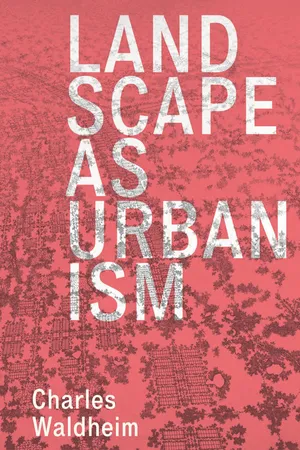
- 216 pages
- English
- PDF
- Available on iOS & Android
About this book
A definitive intellectual history of landscape urbanism
It has become conventional to think of urbanism and landscape as opposing one another—or to think of landscape as merely providing temporary relief from urban life as shaped by buildings and infrastructure. But, driven in part by environmental concerns, landscape has recently emerged as a model and medium for the city, with some theorists arguing that landscape architects are the urbanists of our age. In Landscape as Urbanism, one of the field's pioneers presents a powerful case for rethinking the city through landscape.
Charles Waldheim traces the roots of landscape as a form of urbanism from its origins in the Renaissance through the twentieth century. Growing out of progressive architectural culture and populist environmentalism, the concept was further informed by the nineteenth-century invention of landscape architecture as a "new art" charged with reconciling the design of the industrial city with its ecological and social conditions. In the late twentieth and early twenty-first centuries, as urban planning shifted from design to social science, and as urban design committed to neotraditional models of town planning, landscape urbanism emerged to fill a void at the heart of the contemporary urban project.
Generously illustrated, Landscape as Urbanism examines works from around the world by designers ranging from Ludwig Hilberseimer, Andrea Branzi, and Frank Lloyd Wright to James Corner, Adriaan Geuze, and Michael Van Valkenburgh. The result is the definitive account of an emerging field that is likely to influence the design of cities for decades to come.
Frequently asked questions
- Essential is ideal for learners and professionals who enjoy exploring a wide range of subjects. Access the Essential Library with 800,000+ trusted titles and best-sellers across business, personal growth, and the humanities. Includes unlimited reading time and Standard Read Aloud voice.
- Complete: Perfect for advanced learners and researchers needing full, unrestricted access. Unlock 1.4M+ books across hundreds of subjects, including academic and specialized titles. The Complete Plan also includes advanced features like Premium Read Aloud and Research Assistant.
Please note we cannot support devices running on iOS 13 and Android 7 or earlier. Learn more about using the app.
Information

Table of contents
- Cover
- Title
- Copyright
- Contents
- Preface
- Acknowledgments
- Introduction: From Figure to Field
- One: Claiming Landscape as Urbanism
- Two: Autonomy, Indeterminacy, Self-Organization
- Three: Planning, Ecology, and the Emergence of Landscape
- Four: Post-Fordist Economies and Logistics Landscape
- Five: Urban Crisis and the Origins of Landscape
- Six: Urban Order and Structural Change
- Seven: Agrarian Urbanism and the Aerial Subject
- Eight: Aerial Representation and Airport Landscape
- Nine: Claiming Landscape as Architecture
- Conclusion: From Landscape to Ecology
- Notes
- Index
- Credits